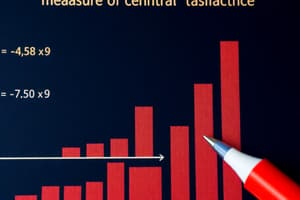Podcast
Questions and Answers
What does variance measure in a dataset?
What does variance measure in a dataset?
- The average of the squared differences between data points and the mean (correct)
- The frequency of data points
- The trend over time
- The average distance between the highest and lowest values
Which type of graph is best suited for analyzing trends over time?
Which type of graph is best suited for analyzing trends over time?
- Line Graph (correct)
- Bar Chart
- Pie Chart
- Histogram
What does the range of a dataset represent?
What does the range of a dataset represent?
- The average value in the dataset
- The number of data points in the dataset
- The distance between the lowest and highest values (correct)
- The difference between the mean and median
Which graphical representation is most suitable for analyzing categorical data?
Which graphical representation is most suitable for analyzing categorical data?
What does a histogram analyze in a dataset?
What does a histogram analyze in a dataset?
In statistics, what does the term 'mode' refer to?
In statistics, what does the term 'mode' refer to?
What is the mean of the following set of numbers: 5, 8, 12, 15, 20?
What is the mean of the following set of numbers: 5, 8, 12, 15, 20?
Which of the following is the mode of the dataset: 7, 9, 11, 7, 13, 7?
Which of the following is the mode of the dataset: 7, 9, 11, 7, 13, 7?
Which measure of dispersion indicates the spread or variability of a dataset?
Which measure of dispersion indicates the spread or variability of a dataset?
What is the most appropriate graphical representation to display the distribution of a continuous variable?
What is the most appropriate graphical representation to display the distribution of a continuous variable?
If the median of a dataset is 25 and there are 20 values in the dataset, what can we conclude?
If the median of a dataset is 25 and there are 20 values in the dataset, what can we conclude?
If the mean and median of a dataset are equal, what can we infer about the distribution of the data?
If the mean and median of a dataset are equal, what can we infer about the distribution of the data?
Study Notes
Understanding Basic Statistics
Statistics is a cornerstone of scientific inquiry and plays a crucial role in various fields such as business, education, psychology, and social sciences. It involves the collection, analysis, interpretation, presentation, and application of numerical data. Key components of statistics include measures of central tendency (mean, median, mode), measures of dispersion (variance, range), and graphical representations of data. Let's dive deeper into each of these aspects.
Measures of Central Tendency
Measures of central tendency give an indication of the typical or representative values of a dataset. The three types of measures are:
Mean
The arithmetic mean is the sum of all observations divided by the total number of observations. For example, if you are calculating the mean of a group of numbers, you would add up all the numbers and divide by the count of numbers in the group.
Median
The median is the middle value when data is arranged in ascending order. Half of the values are higher and half are lower than the median.
Mode
A mode is the value that occurs most frequently in a dataset. For example, if the numbers 5, 5, 5, 8, 12, 14, 21, 33, 38 are listed and 5 appears twice, while all other numbers appear once, 5 is the mode because it occurred most frequently.
Measures of Dispersion
Measures of dispersion indicate the spread or variability of a dataset. Two commonly used measures are:
Variance
Variance is the average of the squared differences between individual data points and the dataset's mean. A high variance indicates that data points are widely spread apart, meaning the data reflects considerable variation.
Range
Range is the difference between the highest and lowest values in a dataset. Simply put, range is the distance between the first value you occur in the dataset and the last value you encounter.
Graphical Representations of Data
Graphical representations visually summarize and illustrate patterns in data. Types of graphs include:
Bar Chart
Bar charts represent categorical data and consist of rectangular bars whose lengths correspond to frequency. Each bar represents a separate category, making comparisons among categories easier.
Line Graph
Line graphs depict trends over time, showing changes in variables and identifying correlations.
Histogram
Histograms are used to analyze continuous variable data, comparing proportions of a variable within defined intervals.
Understanding the basics of statistics, such as measures of central tendency, measures of dispersion, and graphical representations, is crucial for interpreting data and drawing accurate conclusions.
Studying That Suits You
Use AI to generate personalized quizzes and flashcards to suit your learning preferences.
Description
Explore the fundamental concepts of statistics including measures of central tendency (mean, median, mode), measures of dispersion (variance, range), and graphical representations (bar charts, line graphs, histograms). Enhance your understanding of statistics to interpret data more effectively.




